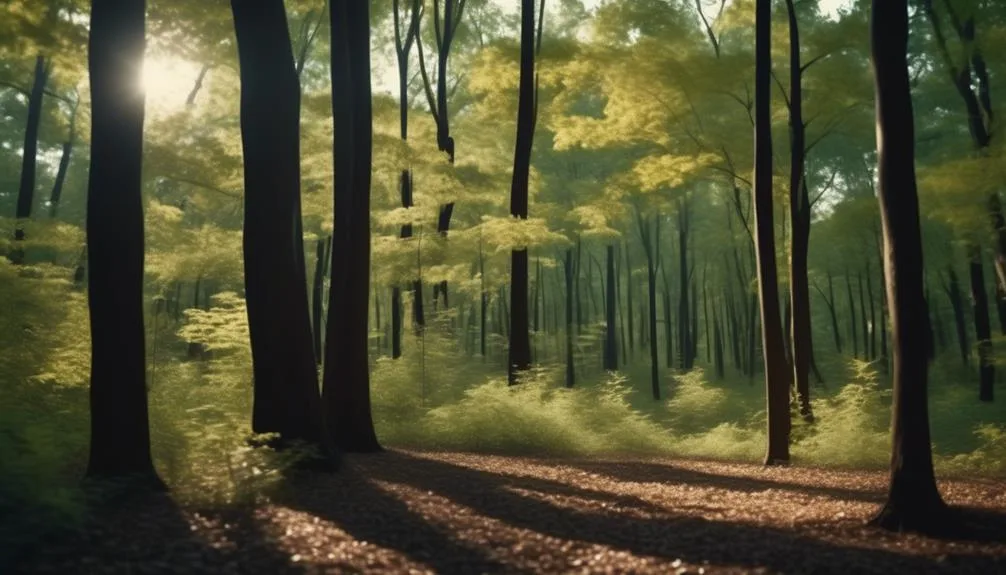Hickory trees, originally from North America, have surprisingly spread to different parts of the world, causing concern. Their invasive nature has impacted various ecosystems.
Stay tuned to learn about the unexpected places where hickory trees are causing trouble and the effects they have on these environments.
Hickory Trees in North America
Hickory trees in North America are renowned for their strength, distinctive bark, and the flavorful nuts they produce. These trees are an integral part of the diverse forest ecosystem in the region.
North America boasts a remarkable tree diversity, and hickory trees play a crucial role in this rich tapestry. They've adapted to a wide range of soils, from moist, fertile bottomlands to dry, rocky uplands. This soil adaptation is one of the factors that make hickory trees so resilient and widespread across the continent.
Their ability to thrive in various soil conditions has contributed to their prevalence in North America's forests, making them a significant component of the region's natural landscape.
Hickory Trees in Europe
In Europe, hickory trees aren't native and are generally considered to be an invasive species in certain locations. The introduction of hickory trees to Europe has raised concerns about their environmental impact and led to the implementation of European regulations to control their spread.
Here's what you need to know:
- Invasive Potential: Hickory trees have demonstrated a high invasive potential in Europe, outcompeting native flora and disrupting local ecosystems.
- European Regulations: European countries have implemented strict regulations to control the spread of hickory trees and prevent their negative impact on the environment.
- Environmental Impact: The presence of hickory trees in Europe can lead to alterations in biodiversity, soil composition, and water availability, posing a threat to native species and ecosystems.
- Management Efforts: Ongoing management efforts include monitoring, eradication programs, and public awareness campaigns to prevent the further spread of hickory trees.
Hickory Trees in Asia
When exploring the presence of hickory trees in Asia, one encounters a complex interplay of ecological and cultural factors that shape their impact on the region. Hickory trees are not native to Asia but are cultivated in some areas for their valuable wood and nuts. The cultivation methods vary across different regions, with some areas embracing traditional methods, while others utilize modern techniques to enhance production. The environmental impact of hickory trees in Asia is a subject of concern, as their introduction can disrupt the local ecosystem. Here is a table summarizing the cultivation methods and environmental impact of hickory trees in Asia:
| Cultivation Methods | Environmental Impact |
|---|---|
| Varied traditional and modern techniques | Potential disruption of local ecosystem |
Hickory Trees in Australia
Growing abundantly in certain regions, hickory trees have become a topic of interest in Australia due to their potential impact on the local environment and ecosystem. The spread of hickory trees in Australia has raised concerns about their environmental impact and the need for effective management strategies.
Here are some key points to consider:
- Environmental Impact: Hickory trees in Australia can outcompete native species, alter soil composition, and affect water availability, potentially disrupting the delicate balance of the local ecosystem.
- Management Strategies: Authorities are exploring various strategies to manage the spread of hickory trees, including controlled burns, targeted herbicide application, and promoting the growth of native vegetation.
- Research Efforts: Ongoing research is focused on understanding the specific impact of hickory trees on Australian ecosystems and developing tailored management approaches.
- Community Involvement: Local communities are encouraged to participate in monitoring and management efforts to mitigate the spread of hickory trees and preserve the native biodiversity.
Hickory Trees in South America
Having explored the environmental impact of hickory trees in Australia, it's essential to understand their presence and influence in South America. In South America, hickory trees pose a significant threat to agricultural lands as they outcompete native vegetation, impacting crop production. Additionally, they are considered an invasive species, disrupting the balance of the local ecosystem. Their rapid growth and ability to dominate the landscape can lead to a decline in the diversity of plant species, affecting the overall ecosystem and wildlife habitat. Here's a table summarizing the impact of hickory trees in South America:
| Impact | Description |
|---|---|
| Ecosystem Impact | Disruption of balance |
| Wildlife Habitat | Reduction in diversity |
| Agricultural Threat | Competition with native crops |
| Invasive Species | Threat to local flora |
Hickory trees' presence in South America highlights the importance of managing invasive species to preserve the region's biodiversity and agricultural productivity.
Conclusion
In regions outside of North America, hickory trees can disrupt ecosystems and outcompete native plants, leading to their classification as invasive species.
Understanding and managing their impact is crucial for preserving the balance of these environments.
Mark Hoffman is a dedicated arborist and tree care specialist with over a decade of experience. His love for trees began when he visited Yosemite National Park as a teenager and was awestruck by the giant sequoias. Mark pursued his passion by studying forestry at Michigan Technological University, where he earned a Bachelor of Science degree.
Since then, he has worked tirelessly in the field of arboriculture, helping to preserve and protect trees in his community. His expertise and dedication have made him a respected leader in the industry and a valuable resource for anyone seeking advice on tree care.
